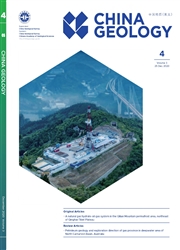Eocene uplift and exhumation in Gangdese area: Evidence from zircon U-Pb ages and Al-in-biotite geobarometer
作者:Aorigele Zhou,Ju-xing Tang,Ming Zheng
摘要:1.Objective The surface uplift history of the Tibetan Plateau is a hot topic in geosciences.The evidence from stratigraphy,geochronology of potassium-rich lava and studies of apatite fission tracks indicated that the Lhasa and southern Qiangtang terranes were at or close to their modern elevation since 40 Ma and formed the proto-Tibetan Plateau(Wang CS et al.,2008).However,uplifting mechanism of the southern margin of the proto-Tibetan Plateau is not well understood(Wang CS et al.,2008;Fig.1a).Lhasa-Woka ductile shear zone(LWDS),the eastern part of Xietongmen-Lhasa-Woka ductile shear zone,is a large-scale E-trending belt in Gangdese and is located in the southern margin of the proto-Tibetan Plateau.LWDS characterized by typical ductile shear zone at the easternmost part,whereas crop out as southward thrusting fault system at the western part,namely the Jiama-Qulong ore district and adjacent area(Fig.1b).
发文机构:Ministry of Natural Resources Key Laboratory of Metallogeny and Mineral Assessment
关键词:UPLIFTTIBETANeastern
分类号: P53[天文地球—古生物学与地层学]
- Discovery of shale gas from Wufeng-Longmaxi Formation in Xianfeng area, Hubei Province, China
- Deep gold mineralization features of Jiaojia metallogenic belt,Jiaodong gold Province:Based on the breakthrough of 3000 m exploration drilling
- Baddeleyite and zircon U-Pb ages of the ultramafic rocks in Chigu Tso area,Southeastern Tibet and their constraints on the timing of Comei Large Igneous Province
- Genesis of green sandstone/mudstone from Middle Jurassic Zhiluo Formation in the Dongsheng Uranium Orefield, Ordos Basin and its enlightenment for uranium mineralization
- Effects of heavy metal pollution on farmland soils and crops:A case study of the Xiaoqinling Gold Belt,China
- The second natural gas hydrate production test in the South China Sea
- Origin of the Oligocene Tuolangla porphyry-skarn Cu-W-Mo deposit in Lhasa terrane,southern Tibet
- Protoconodont fossils for refining the Cambrian bottom and the contribution to shale gas formation along the southwest margin of Yangtze Block
- The introduction of traditional Chinese mineral medicine
- Characteristics of tectonic deformation of the melange zone in the Lachlan Orogen along eastern coast of Australia


